Recent rumors—confirmed in part by Mark Russell, Smith Memorial Student Union general manager—circulating in the student government indicate that the Smith Advisory Board is considering asking for funds to start a remodel of the building’s subbasement, which currently houses Portland State’s student media.
Reclaiming the underground
Recent rumors—confirmed in part by Mark Russell, Smith Memorial Student Union general manager—circulating in the student government indicate that the Smith Advisory Board is considering asking for funds to start a remodel of the building’s subbasement, which currently houses Portland State’s student media.
Such a remodel would rework the space already occupied by student media, and “would include recarpeting, upgrading the lighting and generally improving the aesthetic quality of the space,” Russell said in an e-mail.
“There may also be a redrawing of the floor plan so as to enlarge or shrink certain office spaces,” he added, “or to carve out a common office area where student groups could collaborate and store materials.”
Any renovations that would require reductions in office space to create such a common space would be subject to further approval by the Advisory Board and the Smith Space Allocation Committee, according to Russell.
Furthermore, the funds to accomplish such a project depend on the amount received from the Student Building Fee, but a number has not yet been handed down.
The SBF is a fee collected from tuition each term at every university in the Oregon University System. This fee is then pooled statewide, and the balance is used by the organization to pay down “tax-exempt municipal bonds,” according to a video on the OUS capital construction Web site.
These municipal bonds are then used to fund capital projects at Oregon universities, where the various student government associations recommend which projects the money will be used for. In this case, the Smith Advisory Board will make its own recommendations after a timeline for SBF allocations is determined.
While the present plans are only to consider changes in the student-occupied section of the subbasement space, a glance at the university floor plan shows that though it is not the only open area on that level, it is the only accessible one.
A large part of the floor plan shows no public access, and is part of an area that houses University storage, among other things, Russell said. That area, however, encompasses nearly half of the entire space in the sub-basement.
According to Facilities and Planning’s “Building Area Inventory,” of the gross area square footage in the SMSU there are roughly 69,000 unused square feet of space.
Much of this space is most likely unusable—due to coding restrictions or necessary empty spaces in certain areas—for anything but what it is now being used by the university.
However, there may be a benefit to advocating for some storage space reclamation for the use and benefit of student groups who populate SMSU.
“The most pressing need that I see from student groups is for storage,” said Aimee Shattuck, director of Student Activities and Leadership Programs, in an e-mail.
For its part, the university is making a sweeping effort to update problematic and outmoded infrastructure, and to create new space as enrollment continues to grow every year. Most recently, such projects have included the new student recreation center and the ongoing renovations of Lincoln Hall, and will include the Oregon Sustainability Center in the future.
According to the Campus Physical Planning Committee’s “University District Master Plan Needs Analysis” a report from 2006, one underlying goal of such infrastructure changes is to “encourage interaction and reflect campus community diversity” throughout the physical campus.
Currently, PSU is also seeking to expand with a “network of partners in Portland, the Pacific Northwest and increasingly the world,” according to the “Provost’s Welcome” portion of the Portland State Portfolio, which outlines a vision for the university.
According to the welcome message, the wish of PSU to be a state university at the forefront of sustainability, research and global partnerships is a large part of what drives major infrastructure projects. If PSU is to remain competitive, they need to make certain outward changes to their capital façade.




